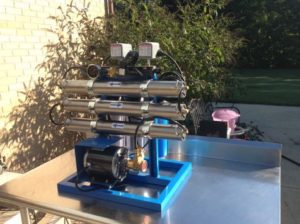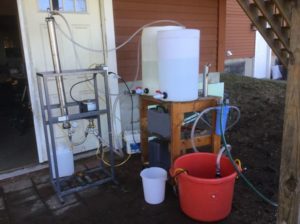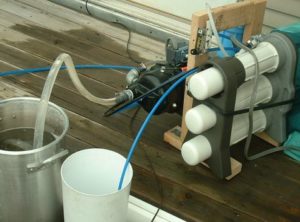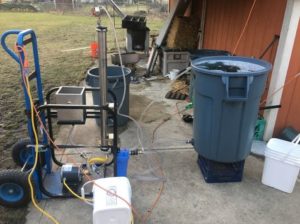Working with Little Reverse Osmosis Units for Syrup Production
One of the biggest drawbacks of making maple syrup for a back yarder or small maple producer is the time it takes to boil the sap into syrup. The idea of using a small reverse osmosis unit to assist with the syrup making is very interesting to many small maple producers. There are many little reverse osmosis systems available for water purification in households or for small commercial applications. These can be purchased from a number of big box stores, home improvement stores, or online. These RO units can be used to remove water from sap to speed up the concentration and syrup boiling process. To make a small RO unit work you must first get the sap under pressure using a pump, typically a shallow well pump.
About 9 years ago, I started experimenting with small reverse osmosis units to try and cut down on the amount of boiling time needed to make my family maple syrup. I started with a GE Merlin that was rated to deliver 30 gallons of pure water per hour when operated at about 60 psi. That rating is for when purifying permeate from water. When you are removing water from maple sap the permeate removal rate is reduced by 6x or I was removing between 4.5 and 5 gallons per hour. This was still a huge benefit for reducing the time of boiling my 25 taps on my 2’ x 4’ wood fired flat pan from about 8 hours per run to 4 hours. It would sweeten the sap from about 2% up to between 4 and 5%. The investment was about $360 for the RO unit and I already had a shallow well pump that I used to pressurize the sap to about 55 psi and had to purchase a pre-filter canister. Though this system reduced my wood use by about 50%, the primary benefit was the reduction in boiling time with no identifiable change in the taste or quality of maple syrup.
In the off-season, the membranes were stored in the unit with permeate created by the unit. I used this unit for 4 years and by the fourth year noticed a slight reduction in performance. To keep the pump from continually turning on and off while feeding the membrane and to maximize the pressure the pressure switch on the pump had to be set at maximum. The 6x reduction in capacity seems to be universal when processing sap vs. processing water with any unit set up and rated for water purification. So a home RO rated for 50 gallons per day would remove about 2 gallons per hour with water or would take about 1/3 of a gallon of water out of your sap per hour. That would be fine for someone with 2 or 3 taps. A larger unit that claims 240 gallons of water purified per day should take out about 10 gallons per hour from water but only about one and a half gallon of water from sap. That should be good for someone with up to 5 to 12 taps. With these water purification units you must remove the carbon filter as it will remove sugar and many other things you normally want in syrup.
Like any normal maple producer, once the small RO was working well and syrup was more efficient to make, I annually added more taps so after using the Merlin for four years it was time to go bigger. I had a larger RO unit come available that had a higher pressure option using a small Procon pump on a half horse power electric motor and one 2.5” by 21” membrane. To this unit I added two more 2.5 by 21” membranes to boost the capacity to handle my now 70 taps. This unit operated at 250 psi, would remove about 15 gallons of permeate per hour and could bring the sap up to 12% sugar if given enough time. So boiling for 70 taps was still taking about 4 hours of boiling time per run only with much greater yield. I continued to use the shallow well pump to feed this unit. As the sap became sweeter, the water removal rate would gradually be reduced.
I found the best way to keep the production high was to process the sap in 15 gallon batches. So, I would hook the RO to a 15 gallon jug of sap and run the concentrate back into the sap jug until the sap reached 10 to 12% at which time the permeate removal would be down to about 8 gallons per hour. The concentrated sap would then head to the boiler. As soon as we started on the next jug of 2% sap, it would rinse out sugar build up in the membrane and go back to the full capacity of 15 gallons per hour. Both of the units above were used in the USDA Forest Farming YouTube videos.
Unfortunately, the three membrane RO made the middle sized RO in the videos look much more complicated than it needs to be, creating lots of inquiries. It was nice that the shorter membranes were easier to transport to maple programs for demonstrations. It seems the 40” membranes and pressure vessels are more standard production than the 14” or 21” alternatives so they are much more economical to purchase for the amount of output. I had the three membranes hooked up in parallel to get the most water removed per hour. If they were hooked in series less water would be removed per hour but the sap could be much sweeter in one pass. For the off season, I would store these membranes in holders made from PVC pipe that would be filled with permeate and a screw tight lid sealing the liquid and membrane in.
It was at this point that I began to gain friends. Friends who would show up at my garage with a 50 gallon barrel of sap or more and we would RO that down to about 15 gallons in about 2 and a half hours but these visits would save them between 8 and 20 hours of boiling time each time the sap ran. But the desire for something bigger was growing. The question of how to make a simple RO that would be most useful for maple operations of 300 to 500 taps lead to the next experiment. The fact that each year in the maple industry some percentage of maple producers are updating their 8” by 40” membranes that have lost some percentage of capacity seemed like it could be a low cost source for operations that don’t need that maximum capacity.
Breezy Maple Farm was updating some of their membranes and provided one for our testing. An 8” by 40” Codeline fiberglass pressure vessel was purchased on line along with a 330 gallon per hour Procon pump. This pump was connected using a cone connection to a standard shaft 1 horse motor that I already owned. This system operated at 250 psi, and would remove about 300 gallons of permeate per hour. Total cost of materials was about $1150. This performed with great efficiency but had a couple of unexpected issues.
At first the pump would run but nothing happened, even when well primed. It turned out that the motor was running backwards, and needed to be rewired. The bolts in the motor were too short to connect to the cone, so they had to be replaced with threaded rod and there was enough vibration in the cone to pump connection that it would wear out the rubber in the motor to pump coupling every couple of weeks. The clamp style connection between a motor and pump seems like a much better system. Here again, I used the feed pump in addition to the higher pressure pump. Some are not using the feed pump, especially if the sap is slightly elevated over the pump so that it can help with priming. This eliminates the cost of the feed pump. I’ve run them both ways but I get less chatter in the high-pressure pump when I use the feed pump but performance seems equal. This system had more capacity than I need and sometimes I had trouble having enough permeate to give the 8” membrane the rinsing it should have following use.
The next year, I tried a 4” by 21” membrane with the 330 gallon Procon pump. This unit did not put out as much as I expected. I had heard that it could do about 60 gallons per hour at 250 psi but I was usually getting about 45 of permeate per hour. Still great for my 70 taps and friends but when you look at the price of the 21” membrane and pressure vessel it is not that much less than a 4” by 40” which will have twice the performance. So, the last year of making maple syrup at home, we tried a 4” by 40” with the 330 gallons per hour pump and it performed very well, delivering 80 to 100 gallons per hour of permeate.
The reason I felt it necessary to put this information together is the over whelming response we have had to the little RO youtube videos. The USDA wanted some Forest Farming Videos, so they sent a crew to tape and record some presentations, which went online a little over two years ago. I figured there were likely a couple of hundred people who would be interested in making their own little RO. There are five videos on youtube talking about RO and covering the three different sizes I had experimented with at that time. As I checked last week, they combined had over 60,000 views and hundreds of people have emailed questions about some aspect about building a little RO.
I hope this information will help answer many of people’s questions so they don’t have to try to track me down. If you are not at all mechanically inclined making your own RO is probably not the best idea. They are becoming more available at more reasonable prices than ever before. Buying one can save significant aggravation. If you are a do it yourselfer, this is a reasonable project to put one together. Some of little ROs from this project are now assisting with concentration of sap at the Cornell Arnot Forest.
Here are a few details that should help:
The Merlin is no longer available.
Flush the RO filters with all the permeate you can save after every use. Do not use chlorinated water in your RO at any time. Store the membranes in pure permeate in the off-season in your pressure vessel or make an airtight holder out of PVC pipe. There are preservatives and soap available for membranes if you need them. Follow suppliers’ instructions and store where children cannot access.
The pressure in the RO is controlled by a valve on the exit end of the membrane on the concentrate line. Permeate comes out of the center of the membrane on both ends, you can block one end so all the water come out one line. The concentrate goes in one end and out the other at the outside fittings by the rings of the membrane. Most small ROs without internal recirculation should send the concentrate back to the sap tank. Concentrate in batches.
Flow meters can be handy, but you can get a quick measure by just putting the permeate line in a 5 gallon bucket and measuring how long it takes to fill it. After a few times, you get pretty good at seeing when you are getting a great flow and when it is slowing down. I get excellent results with my 4×40 with a 3/4 hp pump and a 330 gallons per hour pump. If you get a much smaller pump, say a 150 gph, you get less flow over the membrane at a given pressure which allows the sugar to build up on the membrane and reduce its capacity. The membrane is like a fine screen and the more flow pushing the sugar along the longer it stays clean and functioning. You want a pump that has at least 50% more capacity than the rated capacity of the membrane and more is not a problem.
Change or clean your pre-filter often
Supplies are available in many places. I have used maple dealers, amazon.com, ebay.com, americanro.com, altanticro.com, freshwatersystems.com, nextgenmaple.com and Deer Run Maple plus there are many more.
A sap refractometer is very helpful when working with an RO, as it can give you sugar contents in seconds and harder to break than a hydrometer.
There are many membranes available; I tend to pick the ones with the highest rating for the price.
Starting at the sap tank, here the suggested parts in order: A foot valve, a line to either the feed pump (a valve just after the feed pump can cut down on the need to re-prime the pump so often, shut it when moving the line from one tank to another) or the pre-filter, from the pre-filter a line to the high pressure pump, a line from the high pressure pump to the outside fitting of the pressure vessel, a pressure vessel with a membrane inside, a concentrate line from the outside fitting on the exit end of the membrane that goes back to the sap tank or to a tank suppling the boiler, and a line from the center fitting on the pressure vessel to a tank for storing permeate.
End of season cleaning: For most of the years, I have just run permeate water through the membrane at low pressure, lots of permeate water, and then save the permeate from the water rinsing to store the membrane in. I made a storage chamber out of PVC pipe with a solid bottom and screw on top. Fill the PVC cylinder with the pure water and put the membrane in there completely submerged and put on the top. With our commercial membranes here at the forest, we run a wash using membrane soap from one of the maple supply companies, rinse and do a second soap wash, followed by lots of rinse with permeate – about 350 gallons per 8” membrane. Then store it in a PVC can, like above with membrane preservative added. I have not had trouble just rinsing and storing the membranes in the very pure water but I’ve heard of some who did not rinse enough or get clean enough water for the storage and it smelled bad after storing. I don’t like using the preservative as it takes a lot of rinsing the following season to get the off odor and taste back out of the membrane. I’ve avoided using the soap wash at home as the soap is very caustic (NaOH) and I didn’t want to have it around in case the grand kids happened to get into it. At the forest we have a good cabinet for storing these things.
A special thanks to Next Generation Maple and Deer Run Maple for all the help and encouragement with this project.
For more information on reverse osmosis for maple syrup, visit the Forest Farming YouTube Page.






Is it possible to buy one already to go
Hi Michael, take a look at Next Generation Maple’s website (http://www.homesteadmaple.com/next-generation-maple-products). They have three small RO units listed for sale. CDL also has a few products listed on their website: http://www.cdlusa.com/catalogue/reverse-osmosis/. Hope this helps!
HI, I have built my first ro this year and i am have trouble getting to the pressure that my membrane is suppose to operate at . i have a 1/2 hp jet pump for pumping from holding tank to 5 micron filter and then into a 1/3 hp procon high pressure pump and i can only get about 90psi on the system . dont no whats wrong
Hi Merle, sorry you’re having trouble. The author of this article, Steve Childs, might have some helpful insight. You can reach him at slc18@cornell.edu. Additionally, if you haven’t watched this article’s corresponding video series yet, it might help you troubleshoot: https://www.youtube.com/watch?v=_BOO2L1RD2s&list=PL7w1Cs3YsjxfJOX0E53ggTt3eXqvlNKke&index=2. Hope this helps, and best of luck!
Been eating pure maple syrup all my life. (I’m 64.) The last 6 or 7 years my sister has been gifting me pure Grade A Amber from Vermont. I appreciated it, but told her I wanted her to save her money. So as the supply dwindled this past summer, I bought a 64 oz of grade A dark made by a farm in Locke. Put it in the fridge unopened. Due to a family tragedy, I didn’t open it till this morning. It was not like any real maple syrup I ever had. Very thick. Like it has Karo syrup added. And a slightly “off” taste. Not mold. Very disappointed. Looked up the farm. They have a huge reverse osmosis machine. You’re using these machines for a purpose for which they’re not intended. They’re intended to make pure water, and for the filtrant (waste) to be disposed of. You’re keeping the filtrant, and tossing the water. How do you know some component of the filter membranes isn’t seeping back into the syrup on the downside of the pressure pulse?
How often are you cleaning the membranes, and with WHAT? Do you check the viscosity of your syrup? Do you ever do a side by side tasting of the product produced with the aid of osmosis, vs the traditional method? Do you do so with a clean palate?
Hi Jim,
I would recommend reaching out to the author of the article, Steve Childs, with your questions. He can be reached at slc18@cornell.edu.
Hi to those in the string. We do 150 taps. Would like to produce up to 500. Interested in building an RO system. I’m on PEI Canada. Looking for the stainless canister. Anybody who can help me out? Check out our backyard video at www. Saptosyrup.ca
Thanks
A lot to digest. I’m assembling my RO in Nor-Cal to ship to Vermont next month. My sugarhill is up on ledge and the sugar content low, so i’m looking forward to reducing my late night boils. Very helpful. This will be my fourth year, loving it!
Is the mineral content of the syrup different when using RO?
Hi
How often do we have to change RO membrane ?
What is the Max sugar concentration of sap that we can get using RO ? ( I mean that’s just before boiling )
Where do you get instructions on how to connect thE CDL 550gal/hr RO to the evaporator regarding which pipe is hooked up for the intake and which is for the concentrate,permeate, and waste water?I bought this RO but no instructions included.
I’m interested in building a 4×40 RO system, would you have plans that might help me? Perhaps a parts list
Thank you
I am looking to buy these components. We should have a motor and a well pump kicking around. We will need to buy some fittings and high pressure pipe, foot valve and pre-filter, the procon pump, and the reverse osmosis membrane housings and the membranes. Which membranes work the best for maple sap? There is quite a selection to choose from.